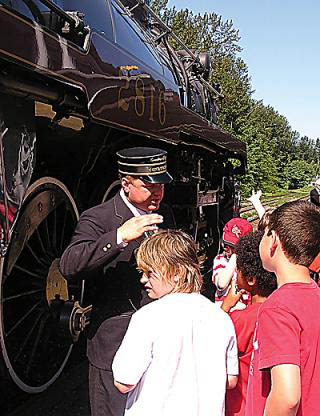
27 June 2008
Steam Train Tracks Back Eight Decades
| |

BC 150 train conductor Jered Hoskins answers questions from a
group of youth at Port Haney station on Friday.
|
Port Haney British Columbia - A piece of history rolled
into Port Haney Friday after chugging in from Sparwood, Fernie, and Yahk.
Canadian Pacific 2816 Empress Steam Train pulled into the station that usually houses the shiny West Coast Express and was mobbed by
old timers and kids as people lined up to tour the travelling museum from another generation.
Lloyd Bostwick, from Maple Ridge, came out to take a look at the 1930 restored steam engine.
He remembered them from the Second World War, when he was in the army and the train carried the troops.
"These trains were all part and parcel of the war effort." They carried troops and prisoners of war, he said. "There
were no airlines. They made the country."
 Sean Morton, 18, showed up with digital camera in hand to get some photos for his dad, who was tied up at work. "It's nice seeing
a piece of heritage, that's for sure," he said.
Sean Morton, 18, showed up with digital camera in hand to get some photos for his dad, who was tied up at work. "It's nice seeing
a piece of heritage, that's for sure," he said.
While people toured the museum car and other restored cars and listened to the band, train fans focused on the steam engine.
The engine was made at Montreal Locomotive Works in 1930 and originally used coal to fire the boilers to produce steam, which drove the
train. When the engine was restored in the 1990s, it was converted to use diesel fuel to fire the boiler.
After stopping at Port Haney until 11:45 a.m., CP Spirit of 150 Rail Tour, a joint project of the province and CP, moved to the Maple
Meadows station in Pitt Meadows at 12:30 p.m. before heading into Vancouver.
Jonathan Morris, 25, from Calgary, was one of the engineers who drove the train across B.C.
"It's a thrill," he said.
"It's the most fun you can have with your clothes on."
Morris said the engine is one of the greenest and most efficient there is after converting from coal to diesel fuel. It uses about 45
to 68 litres per 1.6 kilometres. New diesels use about half that. The train can go about 135 kilometres per hour.
There are no automated systems on the train, he said, so the engineer has to do everything.
"This is exactly how it looked in the 1930s." he said.
He said reaction from the younger generation was interesting.
"For a kid my age - they're saying - what is that?
"It's like Tyrannosaurus rex rolling into town."
|